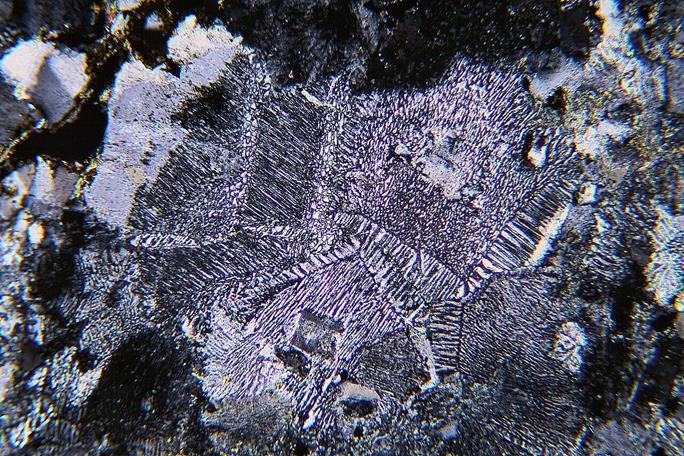Granophyre is a medium-grained, felsic igneous rock with a granite-like composition. This rock is abundant in quartz and feldspar. The quartz and feldspar have somewhat irregular intimate intergrowth.
Felsic rocks are acidic rocks high in silica, i.e., > 63 wt.%. These rocks are also dominated by light-colored minerals, i.e., quartz, feldspathoids, feldspars, and muscovite.
However, they are relatively low in dark-colored, iron, and magnesium-rich minerals called mafic.
Granophyre is an intrusive or extrusive rock. Intrusive means it forms deep beneath the Earth’s surface and extrusive on the Earth’s surface.
Intrusive include subvolcanic (hypabyssal) ones that form close to the surface at depths no more than 2 km (1.2 mi).
On the other hand, extrusive rocks form on or very close to the Earth’s surface.
Lastly, granophyres are genetically related to tholeiitic basalts or mafic intrusions. This genetic relationship is important in describing this rock even when the granophyric texture isn’t as well developed.

Granophyre description and appearance
Granophyre is mostly a light-colored, medium-grained, holocrystalline rock (made of only crystals). However, those higher in mafic minerals are a little darker.
It can be porphyritic or not. Porphyritic varieties have a set of larger crystals called phenocrysts in finer but medium-grained groundmass. The groundmass has a granophyric texture.
Granophyric texture
One distinguishing feature of granophyres is the granophyric texture. This texture has irregular, intimate intergrowth of quartz and alkali feldspars like albite or sanidine, which are common in interstices of porphyritic granophyres.
Granophyrtic texture occurs at a microscopic level, i.e., you can only see it with a microscope. It often has feathery or branching quartz rods inside feldspar crystals.
This texture, to a small extent, resembles a micrographic texture. However, it is cruder and less regular, with some showing vermicular quartz and feldspar intergrowth like myrmekites but often having angular outlines.
Micrographic is a microscopic version of graphic texture common in graphic granite. The graphic texture has visible intergrowths of quartz rods enclosed in feldspar resembling cuneiform or runic writings.
Usually, the granophyric texture is common in porphyritic granophyre groundmass. In these porphyritic rocks, nucleation often starts at the phenocrysts wall and becomes coarse as the intergrowth extends away from the phenocrysts.
How does it form? It likely forms from the simultaneous crystallization of quartz and alkali feldspars in the water-rich last portion of magma melt to crystallize.
The occurrence of druses or druzy fabric is evidenced by irregular cavities lined with mineral crystals.
This intergrowth can happen from supercooling. Such conditions will allow both quartz and feldspars to crystallize simultaneously. There is usually no time for each crystal to grow independently of each other.
For instance, loss of volatiles will raise the solidus, causing supercooling. Supercooling will cause nucleation and growth of quartz and feldspar simultaneously.
Chemical and mineral composition
Granophyre is an acidic rock with more than 63 wt.% silica. Also, it has more than 20% quartz.
Minerals in granophyre are mainly potassium-feldspar, plagioclase feldspar, and quartz. Also, it has minerals like mica, amphibole, and sometimes pyroxene.
The exact composition of this rock may depend on its origin. For instance, those adjacent to basaltic intrusions have pyroxenes and less hornblende (amphibole) as the mafic minerals.
On the other hand, those inside or associated with granites will have muscovite and biotite.
Lastly, in some granohyres, feldspar is turbid and reddish from hematite staining. This possibly indicates they interacted with some of the postmagmatic aqueous fluids.
How do granophyres form?
Those linked to tholeiitic (basalt) intrusion form from magma differentiation. Such are relatively high in iron, a character that differentiates them.
Others may form from the assimilation of subcrustal rocks in basaltic intrusions. The crustal rocks were incorporated at the time of emplacement.
Those from the assimilation of subcrustal rocks include the more felsic in Skaergaard intrusion in Greenland and those found with Karroo dolerites in South Africa.
Where do granophyres occur?
Granophyre rocks occur in close association with or within basaltic magma intrusions. Here, they will appear with other rocks like gabbro, diorites, anorthosites, etc.
An example is the British Tertiary Volcanic Province, where they occur ring dikes, stocks, or phone sheets.
Also, they can occur as dikes, veins, or larger bodies in batholiths, including those of granitic composition.
Frequently Asked Questions (FAQs)
Markfieldite is a granophyre with plagioclase and augite with or without hornblende in a granophyric groundmass.
